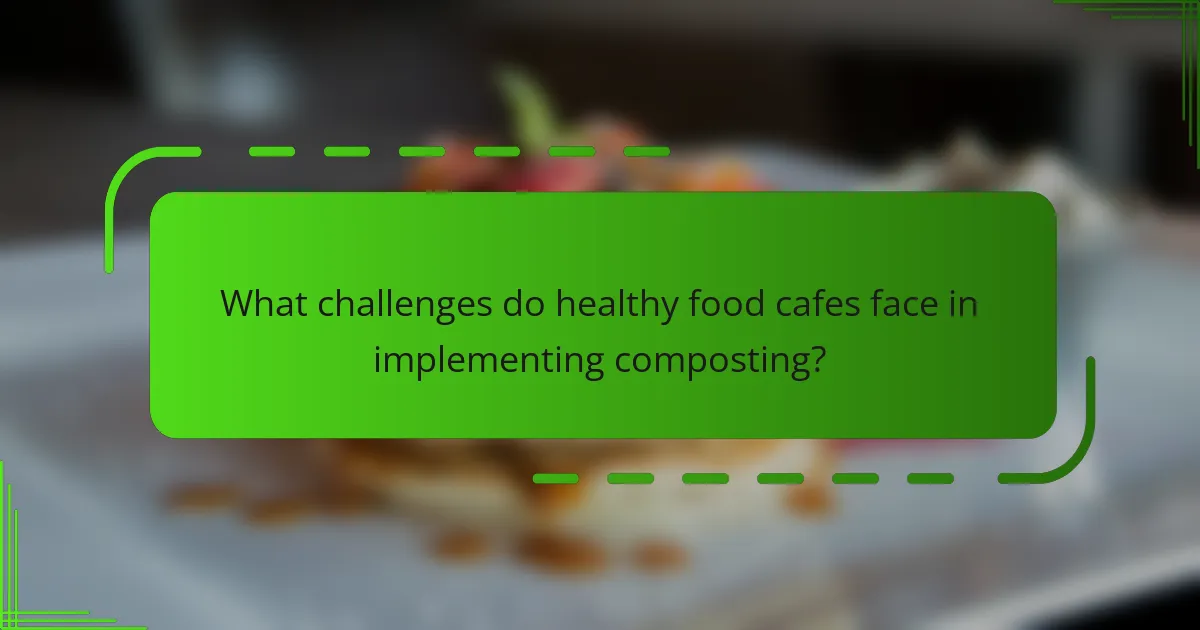Composting practices in healthy food cafes involve the collection and decomposition of organic waste, such as vegetable scraps and coffee grounds. These cafes separate compostable materials from general waste and utilize composting techniques to enhance soil health while promoting sustainability. Challenges faced include limited space for composting, the need for staff training, fluctuating customer traffic, and budget constraints. Successful composting relies on best practices like proper segregation of waste, maintaining a balanced carbon-to-nitrogen ratio, and ensuring adequate aeration and moisture levels. Additionally, educating customers about the benefits of composting is essential for encouraging participation in these environmentally friendly efforts.

What are Composting Practices in Healthy Food Cafes?
Composting practices in healthy food cafes involve the systematic collection and decomposition of organic waste. Cafes typically separate food scraps, such as vegetable peels and coffee grounds, from general waste. This organic material is then placed in compost bins or piles. The composting process requires proper aeration and moisture to facilitate decomposition. Healthy food cafes often use the finished compost in their gardens or donate it to local community gardens. According to the EPA, composting can reduce waste sent to landfills by 30%. Many cafes educate their customers about the benefits of composting, promoting sustainability. This practice not only minimizes environmental impact but also enhances soil health.
How do composting practices contribute to sustainability in cafes?
Composting practices contribute to sustainability in cafes by reducing waste and promoting resource efficiency. Cafes generate significant organic waste from food preparation and customer leftovers. Composting this organic material diverts it from landfills, where it would produce harmful greenhouse gases. Instead, composting transforms waste into nutrient-rich soil amendments. This process supports local agriculture by providing a sustainable source of fertilizer. Additionally, composting reduces the need for chemical fertilizers, which can harm ecosystems. By implementing composting, cafes enhance their environmental responsibility. Studies show that businesses adopting composting can reduce waste by up to 30%. This not only benefits the environment but can also improve a cafe’s public image and attract eco-conscious customers.
What types of organic waste are typically composted in cafes?
Cafes typically compost a variety of organic waste types. Common items include fruit and vegetable scraps. Coffee grounds are also frequently composted. Eggshells can be included as well. Some cafes compost paper products like napkins and coffee filters. Additionally, stale bread and leftover grains are often added. These organic materials help reduce landfill waste and enrich compost. Composting practices in cafes contribute to environmental sustainability.
How is composting implemented in daily operations of healthy food cafes?
Composting is implemented in daily operations of healthy food cafes by integrating food waste collection systems. Cafes typically set up designated bins for compostable materials, such as fruit and vegetable scraps. Staff are trained to separate compostable waste from recyclables and trash. This practice reduces landfill waste and promotes sustainability. Many cafes partner with local composting services for regular pickups. Some cafes also create on-site composting systems to process waste internally. The compost produced can be used in garden projects or shared with local farms. This approach enhances the cafe’s environmental impact and supports local agriculture.
Why are composting practices important for environmental impact?
Composting practices are important for environmental impact because they reduce waste and enhance soil health. Composting diverts organic waste from landfills, decreasing methane emissions. Methane is a potent greenhouse gas, contributing to climate change. Additionally, compost enriches soil, improves water retention, and supports plant growth. Healthy soil leads to healthier crops and reduces the need for chemical fertilizers. Studies show that composting can reduce landfill waste by up to 30%. This practice fosters sustainable agriculture and promotes environmental stewardship.
What environmental benefits does composting provide?
Composting provides significant environmental benefits. It reduces landfill waste by diverting organic materials. Approximately 30% of waste in landfills consists of organic matter. Composting also decreases greenhouse gas emissions. Decomposing organic waste in landfills produces methane, a potent greenhouse gas. By composting, methane emissions can be reduced by up to 50%. Additionally, composting enriches soil health. It enhances soil structure, moisture retention, and nutrient availability. Healthy soil supports plant growth and biodiversity. Composting also promotes sustainable agriculture practices. It reduces the need for chemical fertilizers, which can harm ecosystems. Overall, composting plays a crucial role in waste management and environmental sustainability.
How does composting reduce waste and landfill use?
Composting reduces waste and landfill use by converting organic materials into nutrient-rich soil amendments. This process diverts food scraps and yard waste from landfills. In landfills, organic waste decomposes anaerobically, producing methane, a potent greenhouse gas. Composting, however, allows aerobic decomposition, which minimizes harmful emissions. According to the EPA, composting can reduce the amount of waste sent to landfills by up to 30%. This practice not only decreases landfill volume but also enriches soil health, promoting sustainable agriculture.

What challenges do healthy food cafes face in implementing composting?
Healthy food cafes face several challenges in implementing composting. One challenge is the lack of space for composting bins. Many cafes operate in limited areas with insufficient room for composting equipment. Another challenge is the need for staff training on proper composting practices. Without adequate training, staff may improperly sort waste, leading to contamination. Additionally, maintaining consistent composting practices can be difficult due to fluctuating customer traffic. High customer volumes may lead to increased food waste that is hard to manage.
Cost is also a significant factor. Investing in composting systems and training can strain budgets. Furthermore, some cafes may struggle to find reliable composting services for waste collection. Not all areas have accessible composting facilities, limiting options for cafes. Lastly, there may be a lack of consumer awareness about the benefits of composting. Educating customers can be necessary to encourage participation in composting efforts.
How can cafes overcome barriers to effective composting?
Cafes can overcome barriers to effective composting by implementing staff training programs. Educating staff on proper composting practices enhances understanding and compliance. Regular workshops can reinforce these practices and address challenges. Additionally, cafes should establish clear guidelines for compostable materials. This reduces contamination and improves compost quality. Partnering with local composting facilities can provide resources and support. Utilizing compost collection services ensures proper disposal and management. Lastly, engaging customers in composting efforts fosters community involvement and awareness. Research shows that cafes with active composting programs can reduce waste by up to 30%.
What are common misconceptions about composting in cafes?
Common misconceptions about composting in cafes include the belief that all food waste can be composted. Not all items, such as dairy and meat, are suitable for composting due to potential contamination. Another misconception is that composting is too time-consuming. In reality, many cafes implement efficient systems that streamline the process. Some also think composting will attract pests. However, proper management and sealed bins can prevent this issue. Lastly, there is a belief that composting does not significantly impact the environment. Studies show that composting can reduce landfill waste by up to 30%, contributing to sustainability efforts.
What tools or resources are available to assist cafes with composting?
Cafes can utilize several tools and resources to assist with composting. Compost bins are essential for collecting organic waste. Many cafes use countertop compost containers for easy access. Composting services are available, allowing cafes to partner with local organizations. Educational resources, such as guides and workshops, help staff understand composting processes. Online platforms provide information on best practices and regulations. Compostable products, like utensils and packaging, support waste reduction efforts. Local government programs may offer incentives for composting initiatives. These resources enhance cafes’ ability to implement effective composting practices.
What role do staff and customer education play in composting success?
Staff and customer education is crucial for composting success in healthy food cafes. Educated staff can effectively manage compost systems. They understand proper composting techniques and can address customer inquiries. Customer education fosters participation in composting initiatives. Informed customers are more likely to compost correctly. Studies show that cafes with trained staff achieve higher composting rates. For example, a study by the National Recycling Coalition found that staff training improved composting efficiency by 30%. Thus, education enhances overall composting effectiveness.
How can cafes train staff on effective composting practices?
Cafes can train staff on effective composting practices through structured training programs. These programs should include hands-on workshops demonstrating proper composting techniques. Staff should learn about the types of materials suitable for composting, such as fruit and vegetable scraps. Training should cover the importance of reducing contamination in compost bins. Cafes can utilize visual aids like posters to reinforce composting guidelines. Regular refresher courses can help maintain staff awareness and engagement. Providing resources, such as composting manuals, supports ongoing education. Tracking and sharing composting success stories can motivate staff participation. Research indicates that effective training increases composting rates in food service establishments.
What strategies can engage customers in the composting process?
Engaging customers in the composting process can be achieved through education, incentives, and community involvement. Providing workshops on composting techniques helps customers understand the benefits and methods. Offering discounts or rewards for composting participation encourages ongoing engagement. Implementing a visible composting station in the cafe promotes awareness and accessibility. Sharing success stories and statistics about waste reduction reinforces the positive impact of composting. Collaborating with local organizations for community composting events fosters a sense of belonging and shared responsibility. Regular communication through newsletters or social media keeps composting at the forefront of customer minds.

What are best practices for successful composting in healthy food cafes?
Successful composting in healthy food cafes involves several best practices. First, segregate compostable materials from non-compostable waste. This includes vegetable scraps, coffee grounds, and paper products. Second, maintain a balanced carbon-to-nitrogen ratio. Ideal ratios are around 30:1 for effective decomposition. Third, ensure proper aeration by turning the compost regularly. This promotes microbial activity essential for breaking down organic matter. Fourth, monitor moisture levels to keep the compost damp but not soggy. Too much water can lead to anaerobic conditions. Fifth, educate staff on composting procedures to ensure adherence. Training increases participation and reduces contamination. Finally, partner with local composting facilities if onsite composting is not feasible. These practices enhance compost quality and contribute to environmental sustainability.
How can cafes optimize their composting systems?
Cafes can optimize their composting systems by implementing structured processes and educating staff. Regular training on compostable materials is essential. This ensures that only suitable waste is composted. Establishing clear signage in waste disposal areas aids in proper sorting. Utilizing compost bins with specific labels can reduce contamination. Monitoring composting practices regularly helps identify areas for improvement. Engaging with local composting services can enhance compost quality. Tracking compost output can provide insights into waste reduction. These strategies lead to more efficient composting and a positive environmental impact.
What are the key components of a successful composting setup?
A successful composting setup includes proper materials, balance of greens and browns, aeration, moisture, and temperature control. Composting materials should consist of nitrogen-rich greens, like fruit scraps and vegetable peels, and carbon-rich browns, such as dried leaves and cardboard. A balanced ratio of these materials, typically 2:1 browns to greens, promotes effective decomposition. Regular aeration, achieved through turning the compost, enhances oxygen flow, supporting microbial activity. Maintaining adequate moisture, around 40-60%, is crucial for microbial life. Lastly, monitoring temperature, ideally between 130-160°F, accelerates the composting process and kills pathogens.
How can cafes monitor and maintain compost quality?
Cafes can monitor and maintain compost quality by regularly checking temperature, moisture levels, and aeration. Monitoring temperature helps ensure compost reaches the optimal range for microbial activity, typically between 130°F to 160°F. Maintaining moisture levels between 40% to 60% is essential for effective decomposition. Aeration can be achieved through turning the compost pile, which introduces oxygen necessary for aerobic bacteria.
Additionally, cafes should regularly inspect the compost for odor and consistency. A foul smell indicates anaerobic conditions, while a crumbly texture suggests proper decomposition. Testing the compost for nutrient content can also provide insights into its quality. Regularly adding carbon-rich materials, like dry leaves or straw, can help balance nitrogen-rich food scraps.
Implementing these practices ensures high-quality compost that benefits the environment and the cafe’s sustainability efforts.
What are some innovative composting solutions for cafes?
Innovative composting solutions for cafes include worm composting, also known as vermicomposting. This method uses worms to break down organic waste efficiently. Cafes can set up small worm bins to process food scraps. Aerobic composting systems are another option. These systems require oxygen to decompose waste quickly. They can be installed indoors or outdoors, depending on space. Bokashi composting is also effective. This method ferments organic waste using a special mix of microorganisms. It can handle a wider variety of waste, including dairy and meat. Additionally, some cafes utilize composting toilets to reduce waste. These toilets convert human waste into compost, further minimizing overall waste output. Each of these solutions helps cafes reduce their environmental impact while managing organic waste effectively.
How can technology enhance composting practices in cafes?
Technology can enhance composting practices in cafes by streamlining waste management processes. Smart composting systems can monitor temperature and moisture levels in real-time. This ensures optimal conditions for decomposition. Mobile apps can facilitate tracking of compostable materials and their volume. Data analytics can provide insights into waste generation patterns over time. Automated compost tumblers can accelerate the composting process, reducing time from weeks to days. Sensors can alert staff when compost is ready for use or needs attention. These innovations lead to more efficient and effective composting practices. Studies show that cafes using technology can increase compost diversion rates by up to 30%.
What examples exist of successful composting initiatives in cafes?
Successful composting initiatives in cafes include Blue Bottle Coffee and The Coffee Bean & Tea Leaf. Blue Bottle Coffee composts coffee grounds and food scraps, diverting 150,000 pounds of waste annually. The Coffee Bean & Tea Leaf partners with local farms to compost waste, reducing landfill contributions significantly. Another example is the Café Gratitude chain, which composts all organic waste and educates customers on sustainability. These initiatives showcase effective waste management and environmental responsibility within the cafe industry.
What practical tips can cafes implement for effective composting?
Cafes can implement several practical tips for effective composting. First, they should provide clearly labeled compost bins for customers and staff. This encourages proper disposal of organic waste. Second, cafes must educate staff on compostable materials. Items like food scraps, napkins, and coffee grounds are suitable for composting. Third, they should partner with local composting services. This ensures that collected waste is processed correctly. Fourth, cafes can create a composting schedule for regular bin emptying. This prevents overflow and odors. Fifth, they should monitor the composting process. Regular checks ensure the right balance of greens and browns for optimal decomposition. Lastly, cafes can promote their composting efforts to customers. This raises awareness and encourages community participation. Implementing these tips can significantly enhance a cafe’s composting effectiveness.
Composting practices in healthy food cafes focus on the systematic collection and decomposition of organic waste, such as food scraps and coffee grounds, to promote sustainability and reduce landfill contributions. The article outlines how these practices enhance soil health, minimize greenhouse gas emissions, and support local agriculture. It addresses common challenges faced by cafes in implementing composting, as well as effective strategies for staff and customer engagement. Additionally, the article highlights innovative composting solutions and successful initiatives within the cafe industry that exemplify effective waste management.